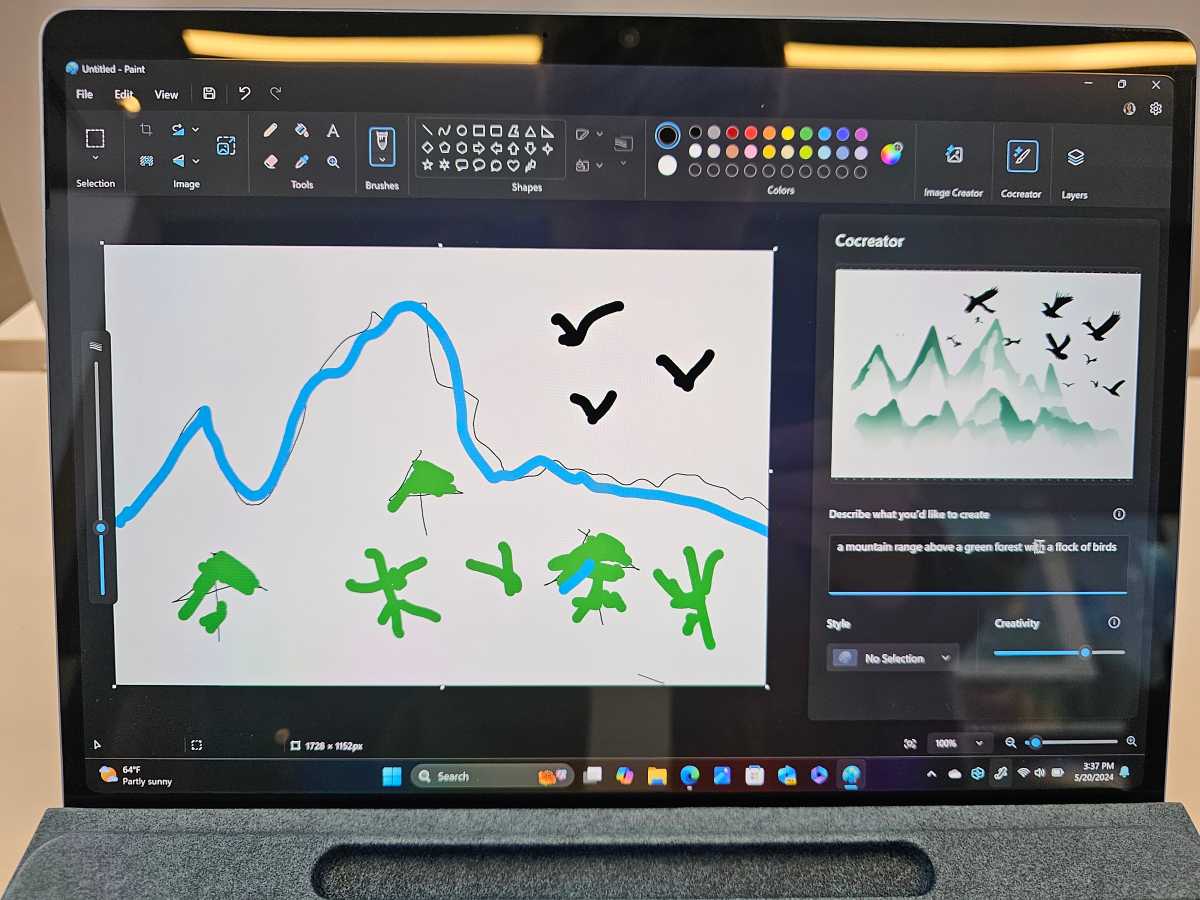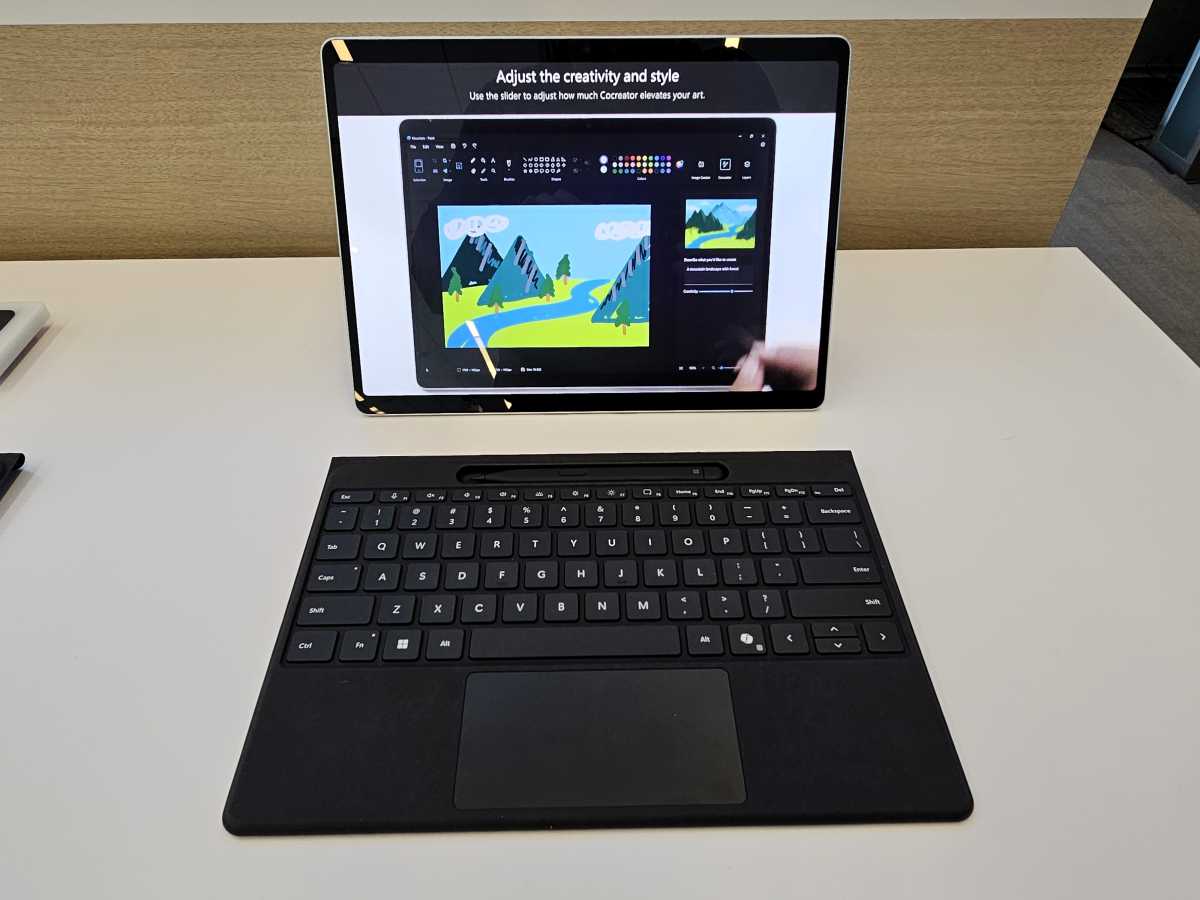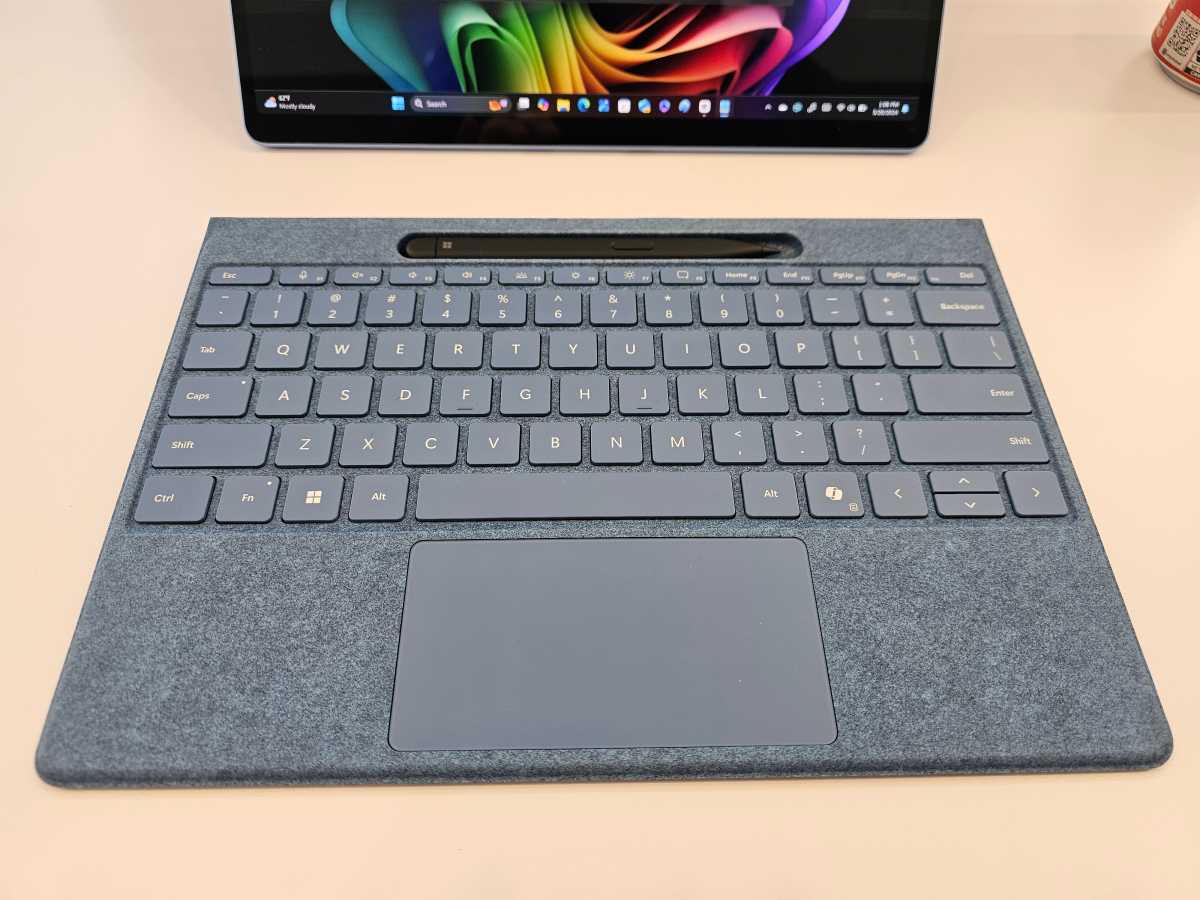Surface VP sitdown: How is AI going to change Microsoft’s PCs?
Microsoft Surface was the brand of devices Microsoft launched to lead the way into the PC market, showing its PC partners what could work in new categories of devices. Now it’s evolving into a new generation, led by AI and Copilot+ laptops.
So what does this mean for Microsoft, Surface, and the evolution of the PC? We sat down with Brett Ostrum, Microsoft’s corporate vice president of Surface devices, this week at the Microsoft Build conference in Redmond and Seattle and asked him to explain it all.
This interview has been slightly modified for length and clarity. It took place on May 20, the day Microsoft launched the new Surface Pro and Laptop.
PCWorld: Thanks for the time today. We now have new leadership in the Surface division. What direction is Surface now going in? What do we need to know?
Ostrum: Great reflection. While true that Panos [Panay] left — Panos and I started the team together back in 2010, and Pavan [Davuluri], Stevie [Bathiche, who designed the first Surface table] have been part of that Surface journey since the very beginning. I think the easy thing for me to say in terms of what’s next for Surface I said in the keynote: we are committed to Copilot+.
While the first generation is on Snapdragon and Qualcomm, Intel and AMD have been part of our roadmaps historically, and we will continue to pick silicon that makes the most sense for our customers. Yusuf [Mehdi, executive vice president and chief consumer officer] mentioned getting Copilot+ PCs out to 50 million customers.
The premium segment that we occupy with Surface Pro and Surface Laptop is certainly a start for us. But in order to do that, we have to hit lower price points and we need to bring devices that resonate for commercial customers and the workloads and jobs that they have to do. And so near term, we are all in on Copilot+, the devices we announced today, but we’ll continue to do the work with our other silicon partners across channels and across price points as we go forward.
 Brett Ostrum, Microsoft’s corporate vice president of Surface.
Brett Ostrum, Microsoft’s corporate vice president of Surface.
 Brett Ostrum, Microsoft’s corporate vice president of Surface.
Brett Ostrum, Microsoft’s corporate vice president of Surface. Brett Ostrum, Microsoft’s corporate vice president of Surface.
Brett Ostrum, Microsoft’s corporate vice president of Surface.Just to confirm: there is a minimum TOPS [trillions of operations] requirement for a Copilot+ PC? Is that true?
Ostrum: Yes. 40 TOPS. 40 TOPS is the minimum, okay. And I think as we as we go forward… Well, I’ll leave it at that. 40 TOPS.
Sorry, I’ll go one step further. That statement, that bar, is so that all of our silicon partners can come along on that journey. The Snapdragon silicon is 45 TOPS, and so there is an element of what is the full capability of an NPU in terms of raw performance. There’s another dimension — how efficient is that NPU. And so as more NPUs show up, there is both of those metrics will absolutely be crucial. In terms of what it looks like, the way that would be reflected in a machine that is not as efficient is lower battery life.
You know, with something like Recall that does take snapshots regularly — if you have a NPU that is not efficient, that can be that can be a tax on the overall battery life of the machine.
Apple had its moment a few years back when it transitioned away from X86 into Arm processors. Is this the moment for PCs to do the same?
We hope that is the case.
I guess I’ll say — sorry. I think in terms of a significant shift in what is capable on a PC? Yes. Arm-specific? No. Okay, I think what Arm brings is power efficiency. And Qualcomm has you know a great set of libraries to pull from a CPU/NPU perspective. And so we certainly wanted to lean on that, but we don’t look at the PC space as all Arm going forward.
Dumb question: Why “Copilot+” PCs as opposed to just “Copilot”?
I’ll let you talk to the marketing folks on that.
Copilot itself is still a cloud-based interaction, right? Microsoft showed off Phi-3-mini, and there was a thought that we’d run Copilot locally on a PC. Is that happening? Or was it announced?
Are you going to Build tomorrow? Stay tuned. [Editor’s Note: Microsoft announced Phi Silica, a language model specifically for Copilot+ NPUs, but has yet to announce a local version of Copilot.]
I’ve been impressed with the various AI improvements you’ve made to various apps: Cocreator and Image Creator, for example. What’s the overarching goal going forward? Sprinkle AI everywhere it makes sense?
I think the easiest ones are that there are some places that running AI workloads on the edge makes more sense. In a case like Recall, having it be local so that it doesn’t have to make a round trip to and back from the cloud. Having it be local, so those images can be stored encrypted on the device from a privacy perspective, it makes sense. When you look at things like the Windows Studio Effects in the camera, it doesn’t matter if you’re in Teams or Zoom, they work. It makes more sensitive to those locally so that again, you’re not trying to do it up in the cloud while that interaction is happening.
 Microsoft Cocreator, in Paint.
Microsoft Cocreator, in Paint.
 Microsoft Cocreator, in Paint.
Microsoft Cocreator, in Paint.Mark Hachman / IDG
 Microsoft Cocreator, in Paint.
Microsoft Cocreator, in Paint.Mark Hachman / IDG
Mark Hachman / IDG
Cocreator is another one where from a creative perspective, I think part of the part of the workflow is that they don’t want to have to set a bunch up and do it one time, wait for the results and then do it again. If I can have the speed of creativity happening and enabled by having it on the edge because it doesn’t have to make a round trip, that’s beneficial. There’s also cases where that running it on the edge is not just faster because it’s on the cloud, but also running it on the NPU is lower power than if it was running on the GPU.
We had the transition from Windows 10 to Windows 11, and many users were left out because of Windows 11’s hardware requirements. Now here are we again. There are lots and lots of PCs that don’t have these capabilities, like an NPU. How do you respond to those people?
They have a very capable machine today. They have a very capable experience today in terms of what they’re able to accomplish, productivity-wise. These new machines bring on a new set of capabilities. And yes, they have requirements in terms of 16GB [of RAM], 256GB [of SSD storage] and 40 TOPS. But those pieces are all necessary to enable those experiences: 16GB, so that you can run those NPU workloads and have everything else that you’re accustomed to; 256GB [of storage], there are some industry trends in terms of storage and capabilities, but also when we are capturing those images. At some point you will set a threshold for how long you want your recall history to be.
And 40 TOPS so that you so that you can not just run one thing at a time, but you can have multiples of these NPU workloads running at the same time. Studio Effects, Cocreator, Recall, all happening simultaneously if desired.
 The new Surface Pro, with the Pro Flex keyboard.
The new Surface Pro, with the Pro Flex keyboard.
 The new Surface Pro, with the Pro Flex keyboard.
The new Surface Pro, with the Pro Flex keyboard. Mark Hachman / IDG
 The new Surface Pro, with the Pro Flex keyboard.
The new Surface Pro, with the Pro Flex keyboard. Mark Hachman / IDG
Mark Hachman / IDG
We’re seeing new Surface Laptops, new Surface Pros. AI is here. How will AI influence hardware design going forward, besides just what’s inside them?
It’s a good question. We talked a little bit about making sure that these devices don’t just show up at the premium space but also that we can get into lower price points and commercial, too, with slightly different drivers for those two dimensions.
We see some different requirements from our commercial perspective: number of ports, screen treatments etc. Price points. Lower price points typically come with smaller screens, less features. In the past we’ve done a mixture of plastics and metal enclosures for those things, relatively straightforward there in the near term. For us, it is about getting the Copilot+ experience across the entire portfolio.
When we say that Surface is committed, and that this is a bet Microsoft is making, you know that there are many OEMs that can fill out niches in the ecosystem. But for us it’s taking this ball and carrying it forward.
Do you still think of Surface as the device that breaks trail or leads the way in that regard?
Yeah. I mean, for me, Copilot+ doesn’t exist if Surface didn’t exist.
Because we were shipping devices, because we were watching what Apple was up to in terms of trajectory on silicon capability, battery life capability, because we were watching what Intel was up to what AMD was up to. When Apple announced the M1 in October 2020, it wasn’t news to us as a Surface team, but it was news to the rest of the company, in terms of the sea change that was happening.
That helped to motivate folks and align folks in terms of getting on a path that was going to be competitive, performance and battery life. When we did that, we had already shipped NPUs on the edge and we felt like watching what was happening in industry that it was going to be an area where we had the potential to differentiate.

The New Surface Pro’s Flex Keyboard.

The New Surface Pro’s Flex Keyboard.
Mark Hachman / IDG

The New Surface Pro’s Flex Keyboard.
Mark Hachman / IDG
Mark Hachman / IDG
And so for me, Copilot+ wouldn’t exist if it wasn’t for Surface and for us watching what was happening in the industry and then helping to align across Microsoft on what would be possible, several years back. So yeah, still leading the charge. And I think you know, it’s awesome to me when we sat down in those early days, the potential of the silicon, what is necessary from a software perspective, bringing developers along, AI experiences.
The role of Surface wasn’t “we want to ship this;” the role of Surface was that we need to inspire the ecosystem to come on this journey. It wasn’t about you know, shipping it in one device, it was showing the commitment and showing the potential. And for us, it meant flipping our retail line, our premium products (Pro and Laptop) over to Copilot+.
You know, we felt like we needed to ship a relevant volume [of product]. Microsoft had been on the Arm journey previously. And customers needed to love those devices and the experiences that we were delivering. And so that really drove the combination of feature sets, price points, the finishes, some of the tradeoffs that we made in terms of what features and what we packed in there.
This feels like the early days of 3D graphics: Rendition, 3Dfx. Everything was blocky and clunky, but in a few years we had Jurassic Park. How do you see AI evolving from a hardware and software perspective?
It’s a great question. Probably the best example I can give is when we started, we said we need to have compelling AI experiences. That’s very non-descriptive. Stephen Bathiche runs our Applied Sciences group. Applied Sciences for us is not research, like out at the horizon, but applied: what are the things that are that that we can reach out and pull in?
And Stevie does a phenomenal job at, hey, here’s 30 ideas that we could consider. And we’ll review those 30 ideas, we’ll pick two of them and say we’re going to ship those as soon as we can. There might be a couple more that we say are super good, but let’s pivot those ever so slightly, and then keep iterating. But it’s always difficult to predict of those 30, which ones are going to resonate.
 Windows Recall promises to allow you to hunt down that one thing you needed, but forgot where you saw it.
Windows Recall promises to allow you to hunt down that one thing you needed, but forgot where you saw it.
 Windows Recall promises to allow you to hunt down that one thing you needed, but forgot where you saw it.
Windows Recall promises to allow you to hunt down that one thing you needed, but forgot where you saw it.Mark Hach
 Windows Recall promises to allow you to hunt down that one thing you needed, but forgot where you saw it.
Windows Recall promises to allow you to hunt down that one thing you needed, but forgot where you saw it.Mark Hach
Mark Hach
We feel really good about Recall, It is super compelling. It is delightful. Once you’ve used it, you fear not having it on a device. So predicting what the next ones will be are hard.
I will say you, for us, it’s really trying to find the jobs that live on the edge. It’s super compelling because there’s so many benefits that exist out there. Exactly what those will be is a little bit unpredictable. I think it’s also safe for us to say that the likelihood that Microsoft is going to come up with all those not going to happen. Our job with developers and third parties is enriching them. I go back to Build this week and make sure we’re equipping them with the tools and the structure to be able to innovate on top of the platform.
Recall is very similar to Windows Timeline, which was launched and then deprecated, or dropped, because it wasn’t used. What’s different this time around?
I will just say this: For me, with Recall, the ability to go back in time is absolutely delightful.
The one thing for me that I find myself using pretty regularly is as I’ll get to the end of the day, I’ll be sending a mail either to communicate something out or that I want more information on somewhere. And I will know that I’ve been in a Teams meeting earlier that day that had a slide or a deck or a table that I want to reference. I’m just able to visually slide back, get to that one slide, grab it, copy, paste, and away I go. Super simple. And that’s when I remember it was from that day.
It’s also doesn’t matter if it’s Teams or Outlook or web or a chat that I was on, or Slack, yeah. It’s just on the screen and I can grab it.
Just the ability to do a search and semantic search is very powerful. In the old days, when you took notes on a pen and paper, you could recognize the notes based on the structure that you had on your paper. When you type something into recall, and you see thumbnails from OneNote, from Outlook, from Teams, from Edge, from PowerPoint — they all show up. It is a rich sea of information that you can dive into to pull that information back out.
But you can’t directly query that document with Copilot, though? You’d have to find it, then pull it up.
If it’s an image, it will go and create semantic indexes on what’s in the image: a blue dress, for example, or a cookie or what have you. It will also identify text and do indexing there.
But for a financial document, you couldn’t ask it what the most profitable quarter was?
From a Recall perspective, no.
You’d have to go back to that document.
Yes.
Thanks for the clarification. OK, a different topic near and dear to some of us at PCWorld: we’ve had a lot of different types of Surface PCs, but never a gaming PC. Why not?
With Surface you know, we tend to be that that place where we’re trying to drive and lead the ecosystem forward. Gaming PCs have been a pretty healthy area for the OEM ecosystem. So in terms of innovate in a specific area, the OEMs have done a phenomenal job in that space.
So from a perspective of Surface as a device that is breaking trail, it is actually those vendors which are carrying the load?
Yeah.
It feels like you guys are a little bit more competitive with Apple than you have been in the past.
I feel like it’s a lot more competitive. [laughs]
But for a while, it felt like Windows existed in its own ecosystem, and Apple in theirs. And you seem to be focused on them more.
Yeah. Well, I think from a Surface perspective, when we started it was about Apple was slowly taking share from the Windows ecosystem. And part of what we were there to do was to, again to show the OEMs that you can compete on a premium category, but it doesn’t just have to be taking share amongst the OEMs. But continuing to play in that premium space, competing with Apple. And so we’ve always considered Apple to be a competitor from a service perspective.
Laptops, Windows